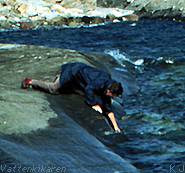Predating and grazing activities
can be an important factor effecting the Biological variety of the
specie. This can happen if one animal prefers to predate on another
competing species and thereafter colonize the area in question. This
predation and grazing can free space so that even other less competitive
specie are able colonize these areas. Even though these creatures
may not be able to defend their space as well, they may grow so they
will not be eaten to same extent as another competing species. In
this way, predators and grazers are able to stop other specie from
competely taking over an area and and becaming the sole colonizers.
Differences in the ability to
colonize also affects predators and other superior competitiors
cannot establish themselves on all spaces every year.
In many countries it is common
for people to visit the beach at low tide to collect different eatable
specie. |
Many different types of organisms
are harvested, such as algae, shellfish, mussels, squid, crabs and
others, all of which end up on the dinner table. In certain areas,
this harvesting is so intensive, that it has an obvious effect on
the beach environment. Several of those organisms that are collected
and consumed are also found in Sweden, at least along the Swedish
west coast. Nevertheless, it is uncommon in Sweden to take anything
more than fish to eat from the beach.
 |


